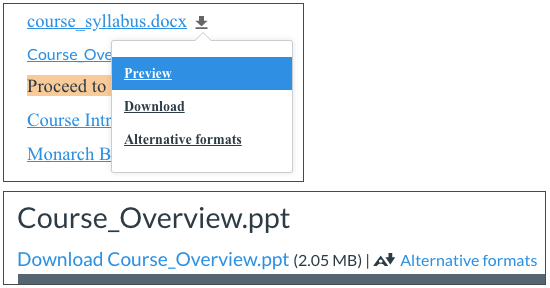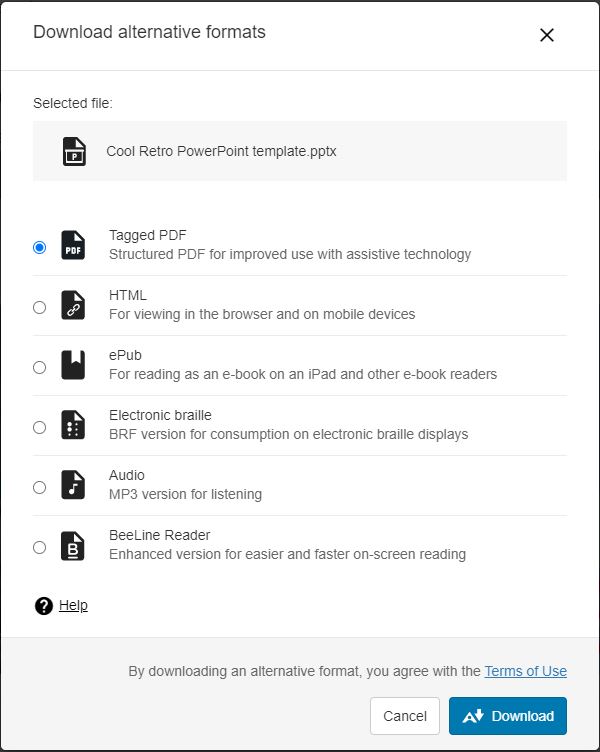Ally Provides Alternative Formats of Course Materials
For information on the faculty Ally interface in Canvas, visit the CETL Ally webpage.
Students can access alternative-format course documents on the fly in a course with Ally enabled. In the Canvas LMS student view, next to each file is a drop-down menu that will reveal an alternate format for the course document. Alternative formats benefit everyone. For example, maybe you have a lot of course material to read and get eye strain, or you're an auditory learner. Listen to an audio format of the learning materials by selecting Audio MP3 from the Ally drop-down.
Don't stick to just one format! Use as many formats as you want. For example, if it isn't in your first language, you could follow along in the ePub as you listen to the audio file, all from the comfort of your favorite coffee shop or study corner. Choose the format, or formats, that best suit your learning needs.
What alternative formats does Ally generate?
Ally provides alternative formats for the following file types:
- PDF files
- Microsoft® Word files
- Microsoft® Powerpoint® files
- OpenOffice/LibreOffice files
- Uploaded HTML files
Ally can generate the following alternative forOCR'd
- OCR'd version (for scanned documents)
- Tagged PDF (currently for Word, Powerpoint, and OpenOffice/LibreOffice files)
- Mobile-friendly HTML
- Audio: MP3
- ePub: for use with personal e-readers, such as Kindle
- Electronic Braille: a braille ready file version for use with an electronic refreshable braille display
- BeeLine Reader
- Language translated version: provides up to 58 language translation options (not available during the pilot)
Which Format Should I Use?
Not sure what format to download? Let us help you decide. This table shows at-a-glance the best formats for your different needs.
| Your needs | Electronic braille | Audio | PDF, OCR | PDF, Tagged | HTML, Semantic | ePub | Translated Version | BeeLine Reader |
|---|---|---|---|---|---|---|---|---|
| Adjust text, font, and background color |  |
 |
||||||
| Adjust audio playback speed |  |
|||||||
| Commuting |  |
 |
 |
 |
 |
 |
||
| Commuting, driving |  |
|||||||
| Copy, paste, and search |  |
 |
 |
 |
 |
|||
| Format adapts to device, responsive |  |
 |
 |
|||||
| Highlighting, note taking, and bookmarking |  |
 |
 |
|||||
| Mobile device |  |
 |
 |
 |
||||
| Offline |  |
 |
 |
 |
 |
 |
 |
 |
| Prefer listening |  |
|||||||
| Prefer reading |  |
 |
 |
 |
 |
 |
 |
|
 |
 |
 |
 |
 |
 |
|||
| Text to speech with speed adjustment |  |
 |
 |
 |
||||
| Different language |  |
The audio alternative reads aloud the text in the original content. This also includes alternative descriptions for images, if they are provided.
The audio format is saved as an MP3. MP3s are compressed, high-quality sound files that can be played on any computer or mobile device.
Maybe these sound like you. If so, audio is a good option.
- You prefer to listen than read.
- You’re an auditory learner.
- You want to read and listen to the content at the same time.
- You have a lot of material to read and find your eyes get tired.
- You read on your commute.
- You don’t want to, or can’t, carry print materials for any length of time.
- You have a visual impairment.
- You want to adjust the speed of the audio.
The electronic braille alternative creates a BRF file that can be read on a refreshable Braille display (RBD), other Braille reading devices, or within a Braille software like Duxbury.
Think of a Refreshable Braille Display (RBD) as a monitor-less computer. Most RBDs can connect to the internet, create documents, access calendars, and a lot of the basic functionality a computer provides. RBDs can be a standalone device. They can also be connected to a smartphone, iPad, or laptop. Most RBDs are limited to reading one line of Braille at a time.
Maybe these sound like you. If so, electronic braille is a good option.
- You have a visual impairment.
- You are familiar with braille.
- You prefer to read.
- You want to read and listen to the content at the same time.
The ePub alternative creates a digital publishing file that can be viewed on mobile devices. ePub files are reflowable. Reflowable means that the content displayed automatically adapts to the device it is viewed on.
Why use ePub?
ePub is powerful. With it, readers can take notes, highlight content, adjust text and background, and in some cases use text-to-speech.
Maybe these sound like you. If so, ePub is a good option.
- You want to adjust font size and background color.
- You want to highlight content, take notes, and bookmark important pages.
- You want to be able to copy, paste, and search text.
- You want to use text-to-speech and adjust the speed of the speech.
- You prefer to read.
- You read on your commute.
Here are a few suggested apps for ePubs.
- Apple: EasyReader, iBooks, Voice Dream, NaturalReader, and Thorium Reader
- Android: EasyReader, Lithium, and Voice Aloud Reader
- Windows: Calibre, Icecream Ebook Reader, NaturalReader, and Thorium Reader
- Linux: Thorium Reader
What is Semantic HTML? Tags and elements—such as blockquote, paragraph, and headings—are added to add meaning to a page. These tags and elements aid screen reader users with good content structure.
Semantic HTML is viewed in a browser and adapts to the device you are viewing it on.
Maybe these sound like you. If so, Semantic HTML is a good option.
- You want to adjust the font size and background color.
- You want to highlight content, take notes, and bookmark important pages.
- You want to be able to copy, paste, and search text.
- You want to use text-to-speech and adjust the speed of the speech.
- You prefer to read.
- You use a screen reader.
OCR stands for Optical Character Recognition. The OCR PDF alternatives are created when the original content is a PDF of an image. OCR technology analyses the content and converts the image into searchable text.
OCR PDF is a good option if:
- You want to be able to copy, paste, and search text.
- You want to use text-to-speech and adjust the speed of the speech.
- You prefer to read.
- You read on your commute.
- You use a screen reader.
A Tagged PDF alternative uses tags and elements—such as blockquote, paragraph, and headings—to add meaning to a page. It aids screen reader users with good content structure.
Why use Tagged PDF?
Maybe these sound like you. If so, Tagged PDF is a good option.
- You want to be able to copy, paste, and search text.
- You want to use text-to-speech and adjust the speed of the speech.
- You prefer to read.
- You read on your commute.
- You use a screen reader.
BeeLine Reader makes reading on-screen easier and faster. Instead of using plain black text, BeeLine Reader displays text using a subtle color gradient that helps pull your eye through your readings. This new display format has been honored by the United Nations and is used by readers in 120 countries around the world.
Why use BeeLine Reader?
BeeLine Reader's color gradient technique not only increases reading speed but also enhances focus. BeeLine Reader is popular among undergraduate and graduate students with heavy reading loads. This includes programs like law, medicine, and the humanities. BeeLine Reader's approach also benefits people with dyslexia, ADHD, low vision, and anybody who may have difficulty with visual tracking or focus.
Maybe these sound like you. If so, BeeLine Reader is a good option.
- You read a lot on screen and wish you could read more easily and quickly.
- You read on your commute and find reading in this environment difficult.
- You prefer to read.
- You have a lot of material to read and find your eyes get tired.
- You read late at night, when your eyes are tired.
- You want to be able to read the content faster.
- You experience dyslexia, ADHD, or low vision.
- You have difficulty with visual tracking or focus.



